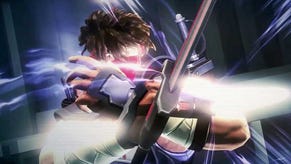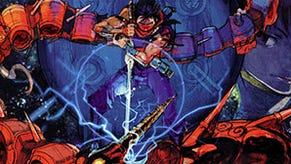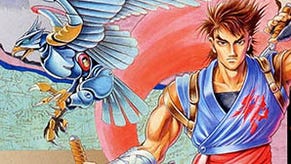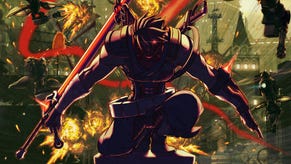Strider's reboot does the Metroidvania dance... and it feels good
Strider's reboot has been a long time coming, and after many false-starts and cancelled projects, Dave feels that Killer Instinct developer Double Helix Games has finally done Hiryu a great justice.
It's no secret that Capcom has tried to reboot Strider before, but for whatever reason it fell to Double Helix Games to deliver that concept to market.
It must have been an incredibly daunting experience, given that Kouichi Yotsui's 1989 classic still commands the utmost respect from gamers and critics alike, so it's lucky then that the end product is slick and challenging; nailing that same sense of verticality and empowerment envisioned by Yotsui-san all those years ago.
It's a re-working of the original plot that sees Strider Hiryu infiltrating Kazakh City to assassinate ruthless dictator Grandmaster Meio and his army of personal guard. Double Helix has opted for the Metroidvania progression model that sees players unearthing more of the vast world map as they go, with plenty of blocked routes accessible only after they've earned a specific skill or gadget. It's a classic template that rewards exploration; where the fruits of your labour are reflected in how much of the play-space you reveal, rather than a simple completion stat.
That space is wonderfully realised too; with aesthetically pleasing 3D backdrops that lend depth to the 2D action. From the dripping, rain-soaked rooftops of Kazakh's historic districts, to the cold, sterile nature of its underground Gravitron labs, each region is superbly defined to ensure that no real estate gets wasted. It's in the little touches; like seeing terrified residents running to hide in a cupboard as you enter their home, or glancing down neon-lit streets that stretch far off into the distance.
All of this plays stage to Strider's devastating arsenal and feats of vertical exploration. Put simply; if you can reach it you can climb it, and if it breathes you can kill it. The same goes for robotic enemies even though they don't breathe, obviously. Hiryu's command list is furious, enabling gamers to sprint through lines of troops while cutting them apart with his Cypher sword. You'll air juggle them to death, slide under their legs for a back-attack and reflect their bullets with a well-timed blade swipe. You can also perform charged strikes for more range and damage, and unleash Strider's Option upgrades to tip fights in your favour.
Option C is Strider's mechanical eagle that acts as a fast-travel device in the field, and is capable of dive-bombing through enemies in battle, while robotic panther Option B can dash through packs of foes and help Hiryu run quickly between areas on the map. Finally; Option A is a pair of drones that circle the assassin to damage enemies and absorb incoming fire.
"This is a lesson in fan service for sure, and while fans of the original may balk at the Metroidvania format, it actually lends the game some much-needed scale to let Hiryu’s climbing and combat skills breathe."
On top of that you have different Cypher plasma settings such as the bullet-reflection I mentioned earlier, flame based swipes that burn through armour and ice attacks that freeze mechanisms and threats solid. That all of this technicality exists in a 2D platformer is quite remarkable, and fleshes out what could have been a rote experience.
It all works too. You'll get a real pang of accomplishment as you successfully repel each round of a machine gun burst back to its sender, or when you somersault over a giant spider mech while hurling explosive kunai all over its chassis. Strider is a game that makes you want to feel badass, and it does so wonderfully, but like all good games out there it comes with a learning curve that - on hard setting - comes as something of a reality check once you start trying to unlock the formidable gate to Meio's stronghold. Gradually; certain enemies can only have their shields crushed by certain plasma types, while others - such as mech-suit troopers - require a degree of attack pattern memorisation.
That said; when you do eventually hike back to previous districts in search of those hidden concept art collectibles or extra Hiryu skins, you'll find that the enemies there won't have received a similar upgrade. This can make hunting for secrets a little-less exhilarating, but it's a minor issue. I also had a problem with the game's boss sisterhood - the Winds - because while you fight them one at a time to begin with, you'll start battling them together over several familiar encounters. It's a bit like lazy boss rushes in classic titles but again; it's not a deal-breaker. Overall; there are some ace boss encounters in here, particularly an early encounter with hulking mecha-snake Ouroboros. That's one to watch out for.
Combat and striking visuals are only part of the classic Strider DNA, because as many of you seasoned gamers will recall, Capcom's original offered unparalleled traversal throughout its world. Double Helix has worked hard to bring that sense of vertigo and height back into the modern day. There are plenty of wide areas designed to get you climbing around and shimmying along ceilings, as well as obstacle courses full of electrified walls and sliding platforms that must be cleverly navigated to pass unscathed. It all gets a bit nostalgic once you hit the first Graviton lab which - as the name suggests - features skewed gravity. You may remember a similar concept from the original.
You'll fly around pulsing orbs, double jumping between gravity wells while slicing automated turrets as you go, all to the tune of the remixed Strider soundtrack. This is a lesson in fan service for sure, and while fans of the original may balk at the Metroidvania format, it actually lends the game some much-needed scale to let Hiryu's climbing and combat skills breathe. I've seen far worse reboots and remakes out there, but I have to say that personally; I had an absolutely blast playing this treatment. It made me feel both deadly and powerful, just as a Strider game should.
We'll probably never know what Capcom's previous Strider suitors had in mind for their own reboots before they got cancelled - and I'm particularly intrigued by GRIN's approach - but I'm glad that the reboot-proof hero has finally been given the present-day transition he deserves.
Disclosure: To assist in writing this piece, Capcom send Dave a download code for Strider on PS4.











